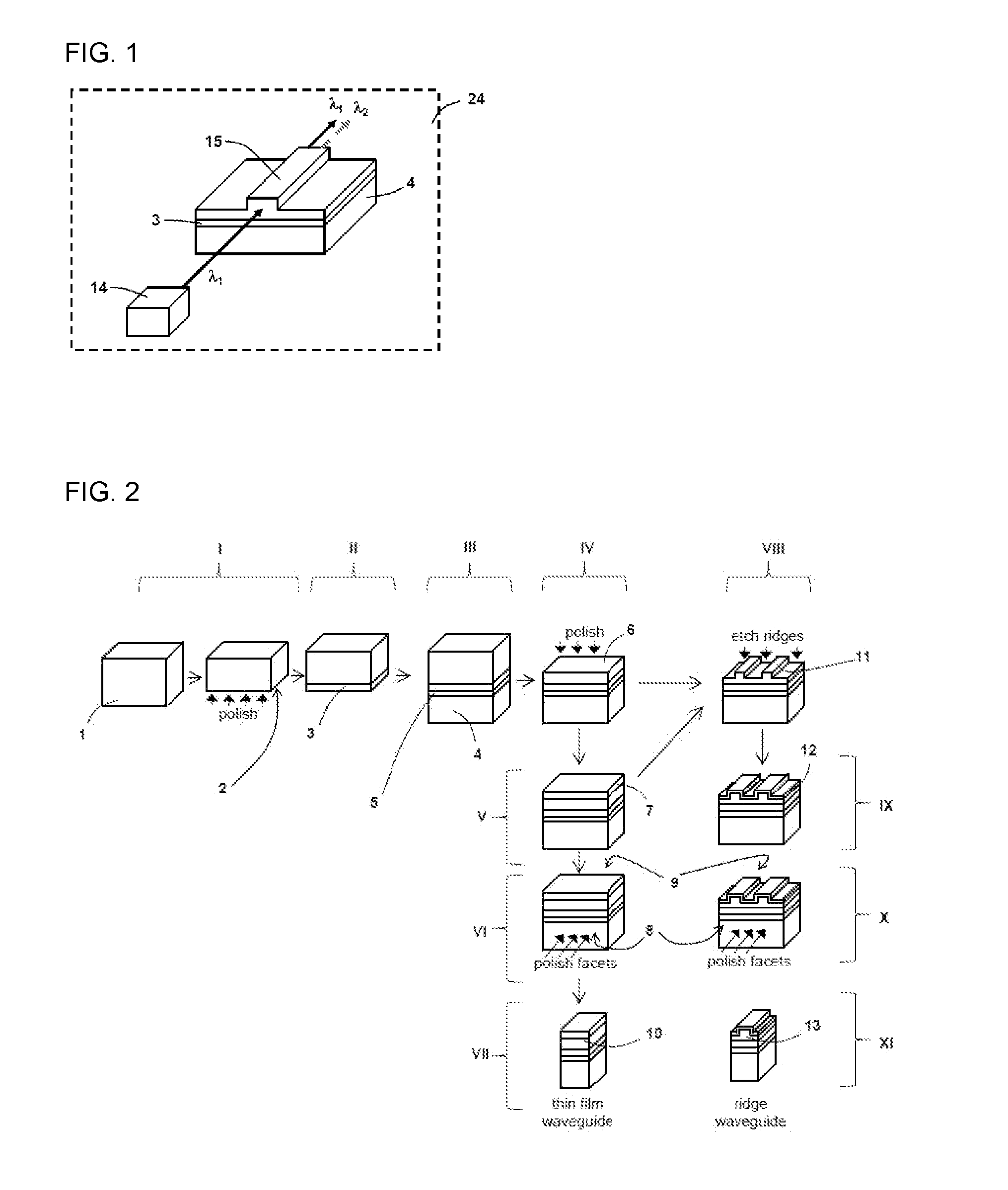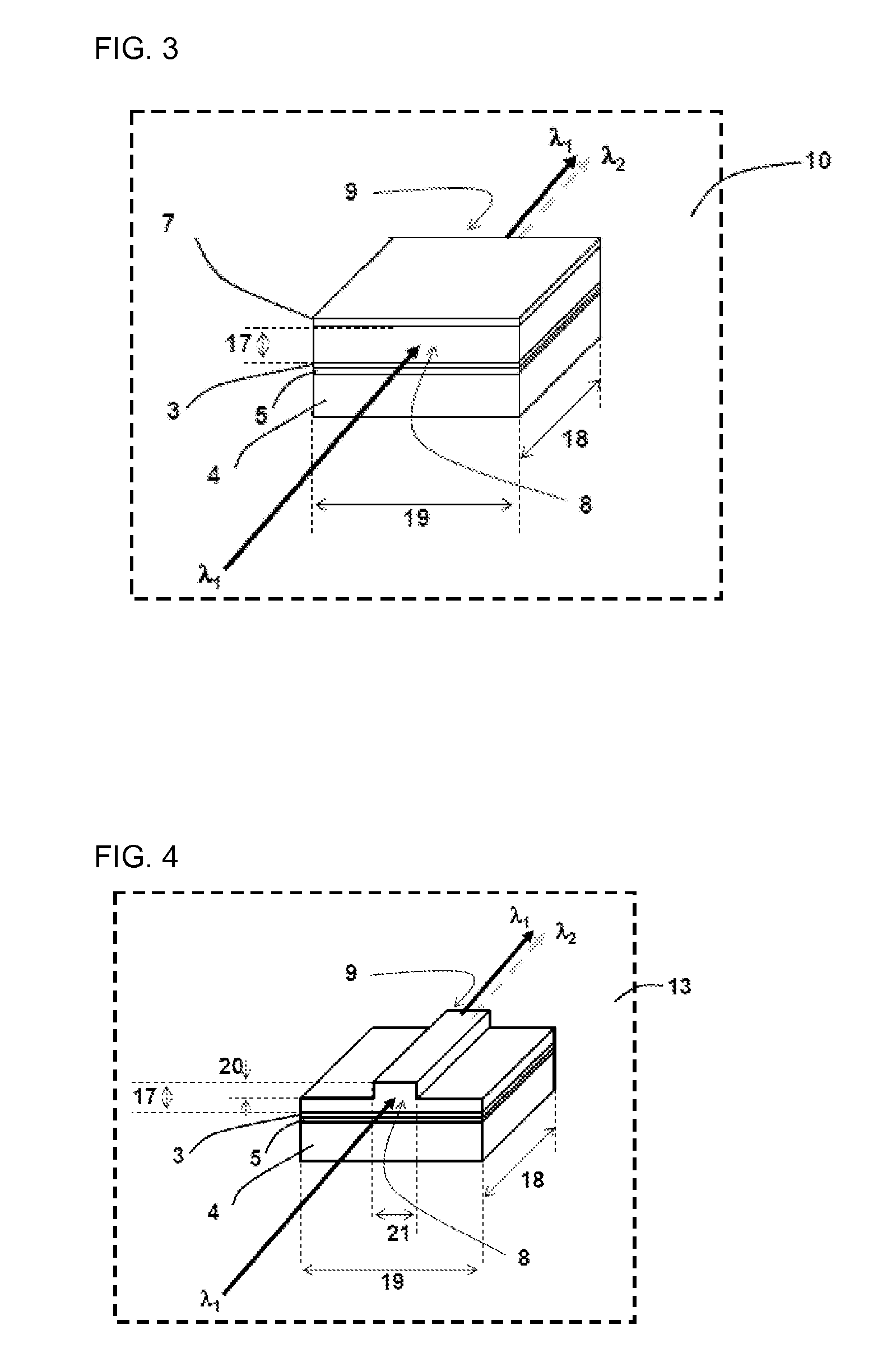Ultraviolet laser
a laser and ultraviolet light technology, applied in semiconductor lasers, instruments, other domestic objects, etc., can solve the problems of high driving voltage, short operating life and long warm-up time, toxic materials in mercury lamps, etc., and achieve the effect of reducing the wavelength range of ligh
- Summary
- Abstract
- Description
- Claims
- Application Information
AI Technical Summary
Benefits of technology
Problems solved by technology
Method used
Image
Examples
example 1
[0137]The first embodiment of the present invention is now described. The laser device 24, illustrated in FIG. 6, comprises of a semiconductor laser diode 14 to generate a visible laser light with a wavelength, λ1, in the range 400-560 nm which is coupled into a frequency doubling crystal of BBO taking the form of a single crystal thin film ridge waveguide structure 15. λ1 is preferably in the range from 410 nm to 460 nm. The light is coupled from the laser diode 14 to the waveguide 15 using one or more lenses 16 which collect the light emitted from the laser diode 14 and focus the light into the waveguide 15. Preferably, the dominant polarization of the light entering the waveguide has the electric field perpendicular to the interface between the BBO crystal (e.g., the single crystal nonlinear optical material) and the first cladding layer. A portion of the visible light from the semiconductor laser diode is frequency-doubled in the waveguide to generate light with wavelength λ2=λ1...
example 2
[0141]A second embodiment of the present invention is now described. The laser device 24, illustrated in FIG. 8, comprises of a semiconductor laser diode14 to generate a visible laser light with a wavelength, λ1, in the range 400-560 nm which is coupled into a frequency doubling crystal of BBO taking the form of a single crystal thin film planar waveguide structure 22. λ1 is preferably in the range from 410 nm to 460 nm. The light is coupled from the laser diode 14 to the waveguide 22 using one or more lenses 23 which collect the light emitted from the laser diode 14 and focus the light into the waveguide 22. Preferably, the dominant polarization of the light entering the waveguide has the electric field perpendicular to the interface between the BBO crystal (e.g., the single crystal nonlinear optical material) and the first cladding layer. A portion of the visible light from the semiconductor laser diode is frequency-doubled in the waveguide to generate light with wavelength λ2=λ1 / ...
example 3
[0142]A third embodiment of the present invention is now described. The laser device is the same as described for Example 1 except for the orientation of the BBO wafer used in step I of the waveguide fabrication. In this embodiment a single crystal BBO wafer 1 with typical dimensions of 9 mm×9 mm×0.5 mm (or other dimensions as required for the particular application) is used as the nonlinear optical single crystal. The BBO wafer has a BBO crystal direction less than 5° from the direction perpendicular to its principal surfaces (that is the 9 mm×9 mm surfaces) and has the BBO [0001] crystal direction lying in the plane of its principal surfaces. The plane of the first polished surface 2 is less than 5° away from being parallel to a {1-100} lattice plane of the BBO crystal (0° is preferred). The approximate relationship between the crystal directions and the first polished surface 2 of the BBO wafer 1 is indicated in FIG. 9. Commercially available BBO wafers may be sourced with the {...
PUM
| Property | Measurement | Unit |
|---|---|---|
| wavelength | aaaaa | aaaaa |
| wavelength | aaaaa | aaaaa |
| wavelength | aaaaa | aaaaa |
Abstract
Description
Claims
Application Information
 Login to View More
Login to View More - R&D
- Intellectual Property
- Life Sciences
- Materials
- Tech Scout
- Unparalleled Data Quality
- Higher Quality Content
- 60% Fewer Hallucinations
Browse by: Latest US Patents, China's latest patents, Technical Efficacy Thesaurus, Application Domain, Technology Topic, Popular Technical Reports.
© 2025 PatSnap. All rights reserved.Legal|Privacy policy|Modern Slavery Act Transparency Statement|Sitemap|About US| Contact US: help@patsnap.com



